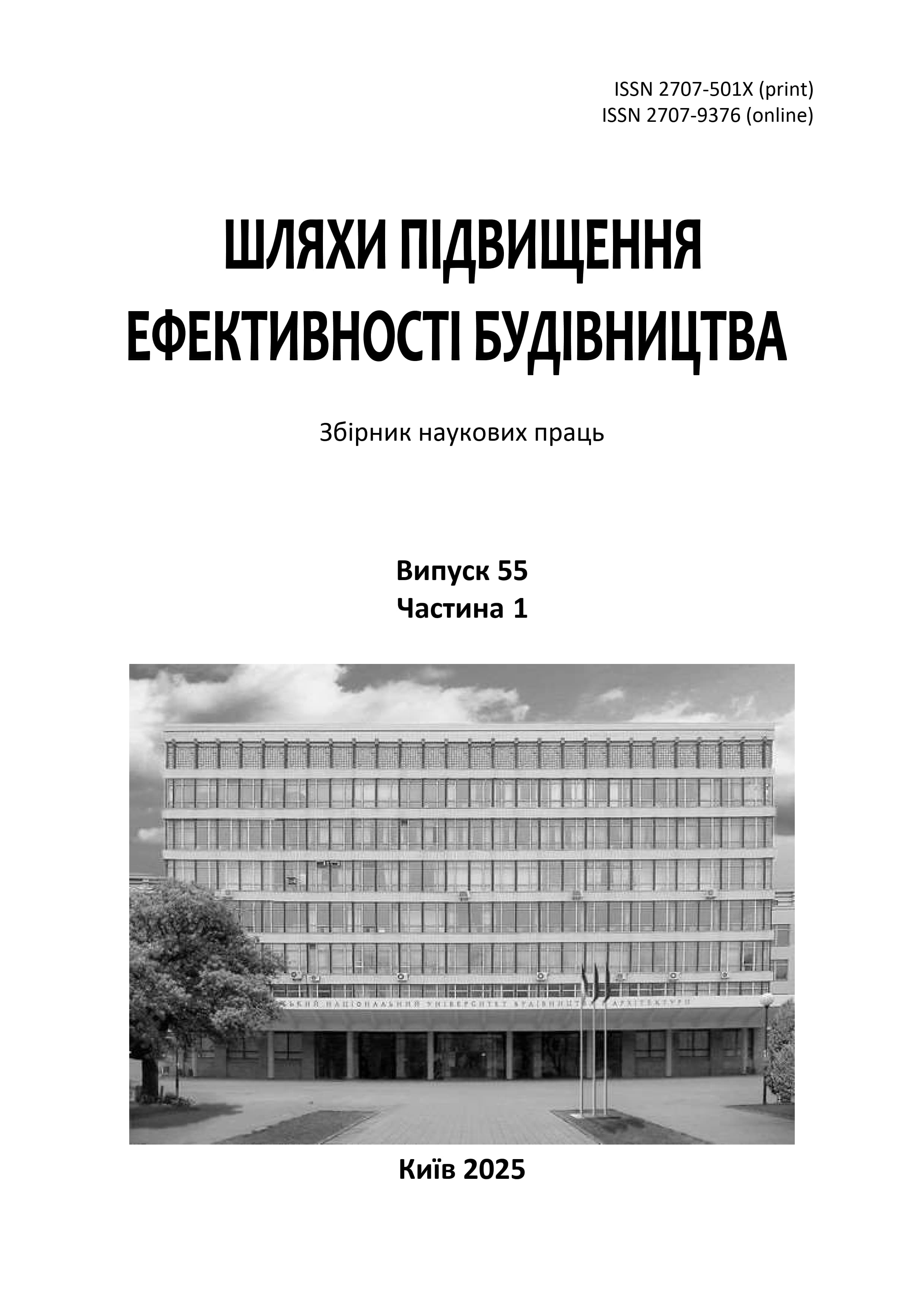Structure of the integrated approach to optimization of the criteria-parameter system of economic management and management of construction projects
DOI:
https://doi.org/10.32347/2707-501x.2025.55(1).201-216Keywords:
integration approach, construction management, economic optimization, resource management, digital technologies, criterion-parametric system, risk management, financial planning, strategic administrationAbstract
Modern construction project management requires an integrated approach to the formation and optimization of economic and management processes. In the context of growing requirements for the efficiency of construction activities, minimizing costs, improving the quality and efficiency of project implementation, there is a need to use an integrated approach to managing the criterion-parametric system. This allows to ensure the adaptability of business processes, their flexibility and compliance with modern requirements for resource management and innovative transformation in the construction sector.
The integrated approach involves a complex interaction between economic, technological and management factors that affect the efficiency of construction projects. In particular, the definition of key parameters that allow assessing economic sustainability, financial efficiency, risk level and resource optimization plays a decisive role in modern management of the construction sector. To achieve these goals, it is important to use modern digital technologies, including artificial intelligence, big data, automated management systems and BIM technologies. One of the key aspects of the effective implementation of an integration approach is to ensure systemic coordination between all participants in a construction project: developers, investors, contractors, state regulators and end users. The interaction of these participants ensures coordinated decision-making, risk minimization and increased economic sustainability of projects.
Optimization of the criterion-parametric system allows reducing transaction costs, reducing the implementation time of construction projects, ensuring transparent planning of financial flows and improving the quality of management at all stages of the project life cycle. Thus, this work is aimed at studying the structure of the integration approach to optimizing the criterion-parametric system of economic management and management of construction projects. The use of this approach allows for the implementation of innovative management methods, ensuring a high level of efficiency of construction enterprises and increasing the competitiveness of the industry as a whole.
References
Al-Obaidy M., Courard L., Attia S. A Parametric Approach to Optimizing Building Construction Systems and Carbon Footprint: A Case Study Inspired by Circularity Principles. Sustainability, 2022. Vol. 14, Issue 6. Pp. 3370.
Tormosov, R., Chupryna I., Ryzhakova, G., Pokolenko, V., Prykhodko, D., Faizullin, A. Establishment of the rational economic and analytical basis for projects in different sectors for their integration into the targeted diversified program for sustainable energy development. SIST 2021. 2021 IEEE International Conference on Smart Information Systems and Technologies. DOI: 10.1109/SIST50301.2021.9465993
Dennis, B.H., Egorov, I.N., Sobieczky, H., Dulikravich, G.S., & Yoshimura, S. (2003). Parallel Thermoelasticity Optimization of 3-D Serpentine Cooling Passages in Turbine Blades. Proceedings of Turbo Expo 2003 Power for Land, Sea, and Air (June 16-19, 2003, Atlanta, Georgia, USA), 1215–1223. https://doi.org/10.1115/GT2003-38180.
Hwang, S. & Jebelli, H. & Choi, B. & Choi, M. & Lee, S.. (2018). Measuring Workers' Emotional State during Construction Tasks Using Wearable EEG. Journal of Construction Engineering and Management. 144. 10.1061/(ASCE)CO.1943-7862.0001506.
Радкевич А.В., Арутюнян І.А., Сайков Д.В. Моделі оптимізації організаційних процесів будівельного виробництва підрядних підприємств України. Управління розвитком складних систем. 2018. № 33. С. 124 – 130.
Підлипний Ю.В., Гуштан Т.В., Каганець-Гаврилко Л.П., Самсонов О.С. Можливості інформаційного моделювання будівель для діджиталізованого управління ризиками в будівництві. Науковий вісник НЛТУ України, 2023, 33(1), 45-51. https://doi.org/10.36930/40330107.
Войтович В. Критерії та основні параметри продуктивності планів будівельних робіт. Управління розвитком складних систем, 2024, (60), 18–23. https://doi.org/10.32347/2412-9933.2024.60.18-23.
Молоканова В., Гордєєва І. Системний підхід до управління проєктами в умовах поведінкової економіки. Управління розвитком складних систем, 2021, (45), 43–49. https://doi.org/10.32347/2412-9933.2021.45.43-49
Нахімі Мохаммад Ясін Мохаммад Хусайн, Новохацька Д.В. Роль використання інформаційних технологій в управлінні будівельними проектами. Управління розвитком складних систем, 2017. № 29. С. 103 - 109.
Данченко О.Б. Методологія інтегрованого управління відхиленнями в проектах. Генеза менеджменту: системи процеси, проекти: колективна монографія: в 2-х томах. Т.1/ за ред. В.Г. Алькеми. Київ: Університет "КРОК", 2024. С. 153-183.
Непран А. Параметричні методи в ціноутворенні: практика застосування. Scientia fructuosa. 2022, 141, 1, 92–105. DOI:https://doi.org/10.31617/visnik.knute.2022(141)07.
Чуприна Ю.А., Петренко Г.С., Гриненко І.М., Ніколаєва М.Ю., Поколенко В.О. Методологічна регламентація та аналітико-інформаційне забезпечення процесно-орієнтованого менеджменту в сучасній системі будівельного девелопменту. Управління розвитком складних систем. 2022. № 48. С. 125-134. https://doi.org/10.32347/2412-9933.2021.48.125-134
Downloads
Published
How to Cite
Issue
Section
License

This work is licensed under a Creative Commons Attribution 4.0 International License.
Authors who publish with this journal agree to the following terms:
- Authors retain copyright and grant the journal right of first publication with the work simultaneously licensed under a Creative Commons Attribution License that allows others to share the work with an acknowledgement of the work's authorship and initial publication in this journal.
- Authors are able to enter into separate, additional contractual arrangements for the non-exclusive distribution of the journal's published version of the work (e.g., post it to an institutional repository or publish it in a book), with an acknowledgement of its initial publication in this journal.
- Authors are permitted and encouraged to post their work online (e.g., in institutional repositories or on their website) prior to and during the submission process, as it can lead to productive exchanges, as well as earlier and greater citation of published work (See The Effect of Open Access).

